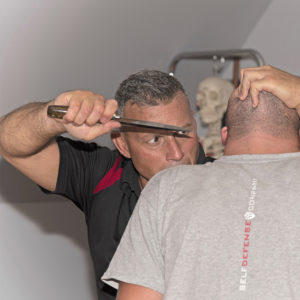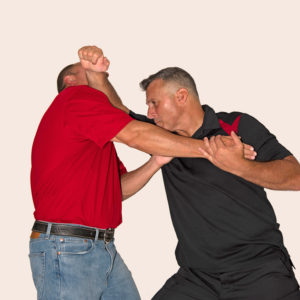
If you believe everything you read in the news, women fail to defend themselves against rape and sexual assault 99.5% of the time while in reality an overwhelming majority of women who resist are successful 87% of the time.
This means the news reports a woman’s self defense success 1 out of every 174 attacks!
The media has subconsciously convinced women they’re weak, helpless victims incapable of defending themselves and in turn, encourages the ultimate irony –to depend on men, the very group who attack them, for protection.
The following research is based on a 1-year survey of 16 newspapers that included 922 articles regarding reports of assault. In almost all except 1 article, news reports reinforced the belief that women are incapable of effectively defending themselves.
*Note references to studies, articles and quotes are indicated by (Name and Date).

Media reports of social issues influence public opinion and perception (Berns 2004; Gilliam and Iyengar 2000; Holbert, Shah, and Kwak 2004; Leverentz 2012; Lowney and Holstein 2001; Repogle 2011; Wozniak and McCloskey 2010).
Through its influence on public perception, news coverage of violence against women can facilitate continued violence against women. (Meyers 1997)
Sheley and Ashkins (1981) found that the public’s view of crime was closer to media reports than to the picture painted by actual police statistics.
For women in particular, media depictions of sexual assault and other forms of violence have been argued to disempower them (Reid and Finchilescu 1995), induce fear (Chiricos, Eschholz, and Gertz 1997), teach them the “victim role” (Gerbner and Gross 1976), and serve as a form of social control, instructing women on the boundaries of virtuous behavior as well as “safe” and “unsafe” environments. (Meyers 1997)
We argue that it’s not simply victims who are constructed through newspaper reports of violence against women, but also gender. Women’s perceived inability to protect themselves by the media has framed them “as the weaker sex.”
Research on the effects of media violence on women suggests that the consequences of these patterns are not trivial.
Since the news media underreports women’s resistance to violence, women may not know that they can successfully resist assault and, because their own belief in their ability predicts their effectiveness (Bandura 1997). In other words if you keep hearing you’ll fail, you’ll believe it and therefore you will never even try.
On the other hand, if the media reported more instances of women’s successful resistance to violence, women may be more willing to fight back.
Unfortunately, about two-thirds of the newspaper descriptions of assaults on women contain no mention of resistance. When newspapers do report women’s self-defensive behavior, they only note its failure.
In only a very small minority of cases are women described as strong, competent social actors who possess the ability to protect themselves from men’s violence.
These patterns are due not only to writers’ and editors’ choices, but also to newspapers’ reliance on police reports, which include only a subsample of all sexual assaults. Combine that with the media’s quest for the most “newsworthy” stories that will increase their readership and only the stories most likely to strike fear an panic get reported.
The double standard of NEWS reporting – When a women defends herself the reporter will often caution against such action, but when a woman is victimized, no such mention of fighting back or resisting is mentioned.
We’re not suggesting in the least that it’s a woman’s fault she doesn’t fight back – it is clearly the fault of the attacker, what we are suggesting is that women who do should be praised for their action.

The consistent presentation of women as powerless victims reinforces women’s place in social hierarchies and substantiating their feelings of vulnerability.
Conversely, potential attackers may learn from newspaper reports that women are vulnerable and unlikely to resist assault; this portrait of weakness may actually encourage sexual assaults.
If you repeatedly hear the same thing over and over again, eventually you’ll believe it. In this case, women are told they’re weak and men are told women are easy targets. Imagine if we started presenting the facts as they were by telling the truth about a woman’s ability to protect her self?
Presenting full accounts of women’s active resistance could challenge gender expectations and making resistance a more cognitively available response to assault (Cermele 2010).
In other words – if women hear more stories of success they’ll be more apt to put up a defense.
Below is firsthand account of resisting assault by Melissa Bruen in 2008 when she was a senior at the University of Connecticut.
This is a good example of how newspapers could report sexual assaults in ways that are empowering to women. Bruen doesn’t discount the fear and pain she suffered; but her account makes clear that she was not a passive victim.
Melissa fought back ferociously and succeeded in escaping multiple attackers.
This is her account:
When he came toward me, I grabbed him by the shoulders and pushed him down to the ground. I held onto his shoulders and climbed on top to straddle him. He started thrashing side to side, but I was able to hit him with a closed fist, full force, in the face.
A small crowd had gathered, mostly men.
Now they seemed shocked. I was supposed to have been a victim and I was breaking out of the mold. I hit him in the stomach while clenching my legs around him to prevent another man from pushing me off.
In all, it took three men to pull me off my assailant.
Another man, around 6’1”, approached me and said, “You think that was assault?” and he pulled down my tube top, and grabbed my breasts.
More men started to cheer.

I punched him in the face, and someone shoved me into a throng of others. I was surrounded, but I kept swinging and hitting until I was able to break free. (Bruen2008)
Bruen in fact does blame herself for taking an unnecessary risk by walking alone at night on UConn’s infamous “Rape Trail”. But she also focuses on what might have happened if she didn’t fight back.
She used her fists and determination to break free not just from one man, but also from many rapists. As a result our heroine sustained only bruises, not rape.
She is brave and powerful and ultimately successful—she was also, understandably, scared and shocked.
But in the original article’s description, she is painted as vulnerable and weak, with very little attention given to her resourcefulness and strength in resisting a crowd of drunken and abusive men.
Studies have demonstrated that forceful resistance is the most effective response to sexual assault.
In large-scale survey research over the past 20 years it was discovered that, as in Melissa Bruen’s case, the majority of women who resist sexual assault are successful.
A Word of Caution: Encouraging women’s resistance cannot be used to blame victims by implying that women are at fault if they don’t resist assault or are unable to do it effectively.
Responsibility for sexual assault always lies squarely on the shoulders of the assailant, not on the women being attacked.
If you choose to resist, there is an abundance of evidence that indicates actively resisting sexual assault significantly reduces the risk of completed rape. (See Ullman 1997, 2007 for a literature review)
In particular, forceful physical resistance (e.g., kicking or hitting), non-forceful physical resistance (e.g., blocking an assailant’s blows or fleeing) and forceful verbal resistance (e.g., yelling) are all associated with avoiding rape.
Women’s physical or forceful verbal resistance does not increase their risk of serious injury beyond the sexual assault itself. (Tark and Kleck 2004; Ullman 1998)
This is contrary to the commonly held belief that if you fight back your attacker will fight harder and cause you more injury.
In Zoucha-Jensen and Coyne’s (1993) study of women who reported an assault to the police (a sample of assaults that may be similar to those reported in newspapers), 44.3% reported using physical resistance.
Women who resist assault:
- Report fewer post-assault symptoms, both physical and psychological (Koss, Woodruff, and Koss 1991).
- Have faster psychological healing (Bart and O’Brien 1985).
- Can result in more compelling physical evidence for any later criminal justice process (Rozee 2005).
Below is another account of a woman fighting off multiple rapists in Park City, Utah:
Park City – Police said the 25-year-old woman left a Main Street club last Wednesday and was walking down Park Avenue when she noticed two men following her.
She quickened her pace, police said, but the men continued to follow.

When she started running, the woman told police that the men caught up to her in a field.
“She claims that when they threw her down, one climbed on top of her and pulled up her shirt and jacket,” Park City Police Lt. Rick Ryan said Wednesday. “She kicked him in the groin and he fell off, moaning and groaning.”
When the other man climbed on top of her and broke her bra clasp, police said the woman punched him in the face.
The men then took off running. (Anon. 2007b)
This powerful description of a woman successfully defending herself was the only such article among the 922 articles in the study sample.
I speculate that if depictions of women’s resistance like this became more widespread, they could both encourage women to resist attackers and discourage men from attempting such attacks.
Women, armed with the knowledge that they have the power to defend themselves and a good chance of succeeding would be able to live a fuller life. Empowering women in this way could not only prevent sexual violence but would also “challenge the status quo by encouraging women to break with traditional role expectations” in all areas of their lives (Meyers, 1997).
Women are not only successful defending themselves, but they do it alone, without any assistance whatsoever.
According to Clay-Warner’s (2002) analysis of NCVS data:
- There’s an 87% reduction in the probability of completed rape when women use any form of self-protective action.
Resistance was successful in stopping the assault in 42% of the attacks. - Assault was only ended by outside intervention 6% of the time.
Women are responsible for their own defense 94% of the time. - Women’s active physical and verbal resistance was more frequently reported as successful (48.2% of 311 incidents) than unsuccessful (35.4% of incidents). In contrast, passive resistance (non-forceful physical and verbal resistance) was reported as unsuccessful (64.6% of 73 incidents) more frequently than as successful (12.3% of incidents).
These results mirror the findings of social science research, which also finds active resistance to be much more effective than passive resistance. (e.g., Clay-Warner 2002; Ullman 2007)
Even if resistance is not completely successful, a woman may be able to escape greater harm by resistance.
This portrayal fits the pattern found in research on sexual assault: when women keep fighting, even if unsuccessful in their initial attempts at resistance, they are more likely to eventually avoid rape (Bart and O’Brien 1985).
What you have been lead to believe by the News
DOES NOT reflect what’s happening in the world (what else is new?)
- Less than 15% (154 of 1,084) of the incidents described in newspaper articles included any description of women’s successful resistance.
- 7% news reports indicated that assailants were strangers to the victim vs. the actual number of around. We found that 62% of newspaper reports sited rapes by strangers but only 31% of police reports had strangers as the attacker. (Kitsuse and Cicourel 1963)
- In the news 41.0% involved acquaintances and other known assailants and 7.3% involved intimate partners or family members.
This is in stark contrast to the facts.
Other researchers report more IPV (Intimate Partner Violence) than Hollander (2014) and national surveys estimate the proportion of rapes and sexual assaults committed by strangers range from 13.8% in the National Intimate Partner and Sexual Violence Survey (NISVS; Black et al. 2011) to 42.2% in the NCVS (Bureau of Justice Statistics 2007).
Most research has found that women are much more likely to resist attacks by strangers than by known assailants (see Ullman 1997, 2002). Women resisted 29.6% of the time when assaulted by a stranger.
However, successful resistance was much more frequently reported in incidents involving strangers: 60% of these incidents, compared with 24% of incidents involving acquaintances and 16.7% involving family members, described women’s successful resistance to violence.
Although there is little research on the efficacy of resistance to strangers versus known perpetrators, the few studies that do measure this, find forceful resistance to be equally effective in both situations (Ullman & Siegel 1993). “There is little research on the efficacy of resistance to strangers . . .” (p. 352), Ullman & Siegel’s 1993 study found resistance effective.
It’s impossible to be exactly certain why newspapers over-represent stranger rapes and underreport resistance to them, or why they underreport the effectiveness of resistance to assaults by acquaintances and intimates.
One possibility is the fact that newspapers often obtain information about sexual assaults from police reports, and women are more likely to report assaults by strangers than acquaintances or intimates.
Another possibility is that reports of assaults by strangers are seen as more “newsworthy,” either because they fit with widespread stereotypes about rape or because they are more sensational.
Whatever the case may be news feature stories tend to report women’s submission with descriptions like these:
“I remembered hearing once that the best way to survive a violent sexual assault was to give in, so I did. The guilt of doing so haunted me for years.” (Weitzel 2007).
“She decided to become submissive, worried that he had a weapon and he’d kill her. A hammer and a razor blade – tools she had used when moving into the apartment – were on her nightstand during the attack but she couldn’t reach them during those two hours. “I just felt so useless,” she said” (Whaley 2007).
What’s notable about these descriptions of submission is the detail about the women’s decision-making process and, in particular, the emotions surrounding such decisions.
These accounts emphasize women’s feelings of guilt, fear, and uselessness; these are not emotions associated with power and control.
News feature stories tend to be 1,500 words long on the other hand, police crime reports by contrast (18% of the 922 articles) are brief, formulaic descriptions of reports made to the police, and average 48 words per article.
Examples:
“A boy at a swim club asked a girl, 6, to touch him under his swim trunks. The girl was hesitant but complied.” (Bolton 2007)
This description contains no extra detail about the emotional turmoil of making the decision to submit.
Short reports are similar, as in this example:
“The second woman did not fight back” (Scallan 2007).
Again, the article provides a simple reporting of the facts, rather than a detailed narrative about why she chose not to fight back.
We can conclude that the longer feature articles developed by news media are embellished or at least tend to focus on women’s vulnerability and fear.
When police crime reports included details about the outcome of women’s resistance, it was described as successful 85% of the time as opposed to the media’s 0.5%.
News articles about women successfully defending themselves are typically shorter than articles describing a woman’s failure or submission.
On the contrary to police reports, there was ONLY ONE incident, among the 60 described in feature news articles, in which a woman was portrayed as strong and capable in her successful resistance to assault:
…a woman “ferociously fought back,” leaving her assailant’s blood at the scene (Johnson 2007).
Shorter articles were not only more likely to report successful resistance, but also tended to frame this resistance in more empowering ways.
For example, some short articles describe women as “fighting,” rather than “struggling,” and some even provide details about the resistance, as in this example: “She elbowed the man, who fell to the ground. She kicked him and ran away.” (Mack 2007).
News writers appear to use the extra space of longer articles to sketch a conventional picture of sexual assault, emphasizing women’s weakness and minimizing or ignoring their ability. Resistance is virtually invisible in this type of reporting.
Of the 922 articles analyzed, only 13 headlines (1.4%) described any sort of female ability to protect her self. Moreover, most of these descriptions of resistance were very weak: two described escape after a completed rape and four described her ability to act after the assault took place. (e.g., helping to catch the perpetrator or trying to help other survivors).
Two articles described resistance during an assault itself, but the resistance was unsuccessful, including one case in which the target was ultimately killed.
Overall, only 5 of the 922 headlines described resistance that stopped an assault. Four of these headlines described active resistance (three physical, one verbal); one described passive resistance (talking a man out of rape).
Thus, while 16% of all articles (150 of 922) had at least one mention of successful resistance, only 0.5% of headlines (5 of 922) did.
Conclusion: A woman’s ability and self-defensive resistance are invisible in newspaper headlines about sexual assault but intended victims can and do fight back with a minimum of injuries and an overwhelming degree of success.
Train Honestly,
Damian Ross
Founder, The Self Defense Company
The research in the article is courtesy of Dr. Bernard McPherson, Phd. who discovered the Self Defense Company while he conducted a survey of martial arts and self defense system. His research has concluded the Self Defense Training System (SDTS) Combatives Program was the most effective and easily learned program available. He feels the SDTS will be able to contribute to a safer society on a grand scale.











Good read as always. Please read this article—-> https://www.jesus-is-savior.com/Womens%20Page/clothing_does_matter.htm
Like!! I blog frequently and I really thank you for your content. The article has truly peaked my interest.